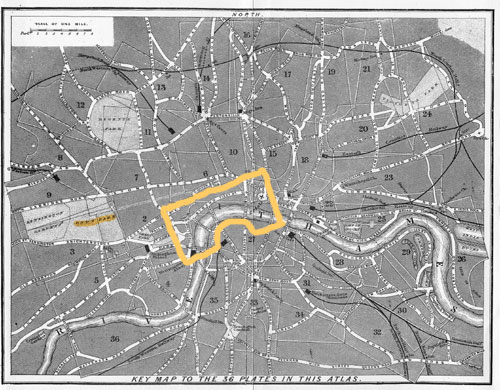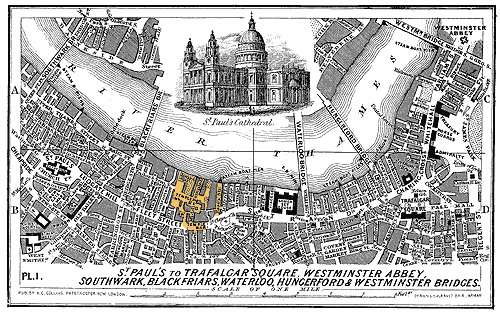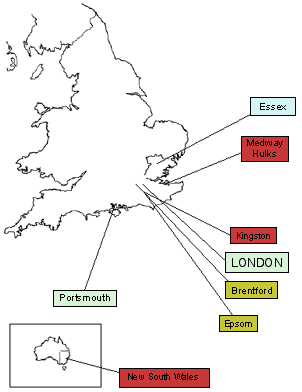NOTES ON THE NOVEL: ISSUE 13
MAPS & ILLUSTRATIONS
A Note on the Maps:
Most of the maps used to illustrate this issue are reproduced from Collins' Illustrated Atlas of London, published in 1854. Pip's London would have been that of the 1820s, and Dickens' London, at the time he was composing the novel, was that of 1860-1. Collins' maps thus represent a London that falls between the historical moment represented in the novel and the historical moment of the novel's composition.
Since the chapters in this issue (Chs. 40-42) take place in late 1828 (Meckier 160), the maps used here show a city that has undergone over 25 years of change since Pip's time. Nevertheless, they are very useful in tracking Pip's progress through the city; the reader should merely keep in mind that some of the landmarks would not have existed in the late 1820s. The most significant of these are the railway lines marked on the Key Map -- the railroad did not enter London until the late 1830s and early 1840s (Tallis's Illustrated London 186-7). The Key Map also shows a bridge that Pip would not have recognized -- the Hungerford Bridge between Waterloo and Westminster Bridges. And London Bridge was, in Pip's time, Old London Bridge -- a different structure, but built in essentially the same place. (New London Bridge would have begun construction a few yards from Old London Bridge when Pip was living in London, but would not have replaced the old bridge during his tenure [Meckier 162]. Given that both London Bridges would have been mapped in the same place, the difference between the bridges makes no difference to our reading of the map.) Any further discrepancies will be noted where appropriate.
History and features of Collins' Atlas (1854)
Collins' Atlas was created in response to the amplified tourist trade in London resulting from the Great Exhibition of 1851. Previous to the Atlas, maps tended to be very large and unwieldy, and though large city maps could be folded up and carried, Collins designed his maps with a specific view to portability (Dyos 10). The Atlas consists of one large map of the whole city of London (the Key Map), followed by 36 plates. The Key Map is drawn with numbered sections, and these sections are represented in detail by the plates (the numbers on the Key Map refer to the numbers of the plates). The chief drawback to the Atlas is that, although the Key Map keeps North at the top, the plates do not always observe this convention (Dyos 13). This disregard of the compass, however puzzling to someone attempting to navigate London in 1854, is in many respects an advantage for the modern reader: The detailed plates -- drawn to represent popular views of the city and/or popular routes through it -- give us a unique view of the sites of Pip's adventures in 19th century London. Any major discrepancies between the landmarks shown on the maps and those that Pip would have been acquainted with (given that the map was composed in 1854, about thirty years after Pip's tenure in London) will be indicated where appropriate.
A tour of chapters 40-42
The Key Map of Collins' Atlas (below), showing London as a whole, gives a useful overview of the locations mentioned in this issue. For instance, Hyde Park, where Magwitch hopes that Pip will establish a "'fashionable crib' ... in which he could have a 'shake down'" (Ch. 40), is visible toward the left side of the Key Map, next to Kensington Gardens (Pip would not have had a residence in the park, but in one of the fashionable neighborhoods in its vicinity). Most of the other locations described in Chapters 40-42 appear in the area designated by numeral 1 on the Key Map, and are shown in detail on Plate 1. All of the maps reproduced here have been highlighted for convenience of reference and increased legibility.

Pip takes rooms for Magwitch -- under the pretense that Magwitch is his "Uncle Provis" -- in "a respectable lodging-house in Essex-street, the back of which looked into the Temple, and was almost within hail of [his] windows" (Ch. 40). Essex Street appears on Plate 1 of Collins' Atlas (below), running parallel to the Temple (at the far right side of the Temple complex) from Temple Bar to the Thames.

If Magwitch's windows are within hail of Pip's, Pip's flat in Gardencourt would be at the rightmost corner of the Temple, bordering on the Thames. This accords with his description of his rooms in Chapter 39: He says that he and Herbert lived "at the top of the last house" in the Temple, and that it had "a lonely character" and was "exposed to the river."
Abel Magwitch tells his life-story in Chapter 42. It begins in Essex County and runs all over England, as well as to the penal colony of Australia. The map below is a graphic representation of the locations named in the course of Magwitch's personal history.
THE EXPLOITS OF ABEL MAGWITCH, 1768-1829
Born, or at least "bec[oming] aware of [him]self" (Ch. 42), in Essex county, Magwitch spent his youth in and out of jails. The specific jails named in his narrative are indicated in red -- the Medway Hulks, whence he escaped and met Pip; Kingston Jail, whence he was released and met Compeyson; and finally the penal colony of New South Wales, to which he was transported for life. Locations associated with Compeyson are marked in yellow; locations associated with Pip are marked in green.

Inset: Australia. Magwitch was transported to Botany Bay, located on the eastern coast of New South Wales just below Sydney.
Abel Magwitch was probably born in about 1768 (Meckier 158-60). As a small child in Essex, he remembers "thieving turnips for [his] living" (Ch. 42); as he grew up, he passed in and out of jails for various offenses. After leaving Kingston Jail (there are a number of Kingstons in England, but we have assumed that Magwitch's Kingston is Kingston-on-Thames because of its apparent proximity to Epsom), he met Compeyson at the Epsom races (Epsom is southwest of London). Compeyson had a house near Brentford (west of London), where Magwitch watched Arthur die. Later tried for his activities with Compeyson, Magwitch was sent to -- and briefly escaped from -- the Medway Hulks. Thereafter, he was transported to Australia for life, but came back from Botany Bay to see Pip. He landed in Portsmouth, and traveled to London.
ALLUSIONS
The imaginary student pursued by the misshapen creature he had impiously made: Pip feels repulsed by Magwitch, as Frankenstein was by his creature. Frankenstein, by Mary Shelley, is a Romantic novel, first published in 1818. It was written as a result of a contest between the Shelleys (Mary and Percy) and Lord Byron. The object of the contest was to write the best horror story, but only Mary Shelley's was completed. Frankenstein, about a young man who brings a creature to life, only to be horrified by what he has made, is still popular.
GLOSSARY OF HISTORICAL THINGS & CONDITIONS
Botany Bay: Botany Bay is a coastal town in Australia, located just south of Sydney. Magwitch, indicating that he is "back from Botany Bay" (Ch. 40), identifies his penal colony as that of New South Wales. There were two Australian penal colonies in the 19th century (New South Wales and Van Dieman's Land), as well as smaller colonies in Bermuda and on Norfolk Island (a volcanic island off the coast of Australia). New South Wales was by far the largest colony. In 1838, the Select Committee on Transportation reported that 75,200 convicts had been sent there since its establishment in 1787 ("Report" 604). In 1840, New South Wales refused to accept further convicts (Mitchell 502).
Bridewells and Lockups: Bridewell became the generic name for a prison, but originally referred to Bridewell Prison in London. The Oxford English Dictionary gives the following etymology: The original prison was named after St. Bride's Well -- "a holy well in London, near which Henry VIII had a 'lodging', given by Edward VI for a hospital, afterwards converted into a house of correction."
Calendar, the: Pip, contemplating Magwitch, "would sit and look at him, wondering what he had done, and loading him with all the crimes in the Calendar" (Ch. 40). The Calendar refers to the Newgate Calendar, a compilation of "recent notorious crimes" published between 1770 and 1820. After 1820, similar publications were occasionally available -- the Newgate Calendar between 1824 and 1826, and the New Newgate Calendar in 1826 (Meckier 181). The sensational nature of the material in these "Calendars" made this kind of publication popular, and weekly magazine-like "Calendars" were also published in the 19th century. Martins' Annals of Crime; or New Newgate Calendar, and General Record of Tragic Events, Including Ancient and Modern Modes of Torture was such a "Calendar." A sort of penny dreadful (the price was literally "one penny"), it was published in weekly numbers. Each number gave sensational accounts of crimes, personal histories of criminals, and descriptions of various kinds of historical punishments. Some features were ongoing, such as a series on "The Most Notorious Pirates" or "The Most Notorious Highwaymen," and ran in several consecutive numbers.
Hair powder, and spectacles, and black clothes -- and shorts and whatnot: The disguises that Magwitch suggests for himself are somewhat out of fashion. Hair powder, though extremely popular in the 18th century, became unfashionable after 1795, when a tax on its wearers was passed. Given the extreme popularity of hair powder at the time, it had been estimated that this tax would produce £210,000 a year (the tax for a year's use of hair powder being a guinea -- slightly more than a pound). The tax, however, essentially killed the fashion (Fairholt 328). Shorts, or knee-breeches, were also somewhat old-fashioned by the time Magwitch thinks of adopting them. In the last decade of the 18th century, buckskin knee-breeches (close-fitting trousers that extended to just below the knee) were considered "immense taste"; afterwards, however, knee-breeches became less popular, and more formal -- Fairholt notes that they were "still worn as court dress" (Fairholt 326, 400) in 1860. It may be that the latter association, however -- of knee-breeches with formality and nobility -- explains Magwitch's "extraordinary belief in 'shorts' as a disguise" (Ch. 40). They imply gentility, and Magwitch -- never before a gentleman, and with vague or overstated ideas of what one looks like -- hopes to disguise himself as such.
Horrors, the: Magwitch relates that "Arthur was dying ... with the horrors upon him" (Ch. 42), hallucinating a woman in white. The horrors, according to the Oxford English Dictionary, refer to a "fit of horror or extreme depression" especially associated with delirium tremens (a result of alcoholism).
Measured my head: Magwitch, recalling that people measured his head when he was in prison growing up, describes a phrenological examination. Phrenology, a dubious but popular science of the time, essentially maintained that personal qualities could be distinguished according to the size and shape of the head. As the Oxford English Dictionary explains, phrenology was a "theory originated by [Drs.] Gall and Spurzheim, that the mental powers of the individual consist of separate faculties, each of which has its organ and location in a definite region of the surface of the brain, the size or development of which is commensurate with the development of the particular faculty; hence, the study of the external conformation of the cranium as an index to the development and position of these organs, and thus of the degree of development of the various faculties." Treatises on phrenology were widely available at the time Dickens was writing. The Dictionary of Daily Wants (1858-9) lists 18 books on phrenology (handbooks, manuals, etc.) and their prices.
Negro-head, loose tobacco: The tobacco that Magwitch smokes, identified by Pip as "negro-head," was a dark kind of tobacco used, according to the Dictionary of Daily Wants (1858-9), almost exclusively for smoking (as opposed to snuff-taking, chewing, etc.) and was often "manufactured in the form of a thickish rope" (1006).
Patience: Magwitch plays "a complicated kind of Patience with a ragged pack of cards of his own" (Ch. 40). According to the Oxford English Dictionary, this is a kind of solitaire -- "A game of cards (either ordinary playing cards, or small cards marked with numbers), in which the cards are taken as they come from the pack or set, and the object is to arrange them in some systematic order."